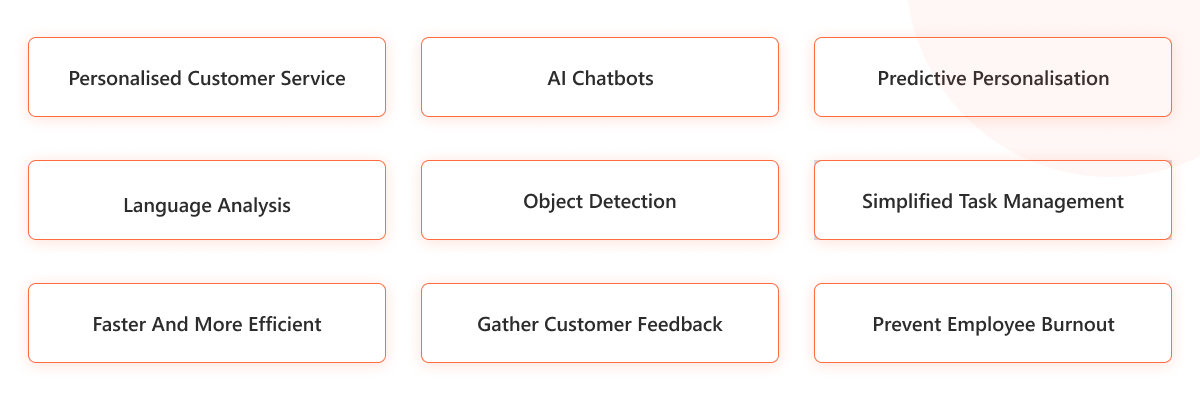Have you ever dialled a customer care line only to be kept on hold for hours on end before the words, “Hello, how may I help you today?” woke you from the psychic trance of the monotonous caller tone.
Let’s look at the same situation from the other end of the phone.
Every day, support teams deal with over 100 customers with identical queries. At the end of the day, you would be so drained mentally.
Here’s a simple solution to all these problems:
AI in customer experience.
Want to know how to use AI to improve the customer experience?
Read on to find out.
Why use AI / ML in customer experience?
Customers in today’s customer-empowered marketplace want a broader vision of what they want, need, and anticipate to reach their full potential. AI and ML may help harmonise customer interaction and experience management strategy throughout all digital channels.
Businesses need to expand their customer base. They make it possible for businesses to acquire an advantage in the marketplace by:
-
-
- The ability to adapt to and satisfy the ever-changing needs of consumers
- They are designing the best possible website for customers to enjoy for the rest of their lives
- To deal with the quick movement in preferences, they analyse their behaviour
-
An improved client connection results from a more customised digital experience.
Here are nine ways artificial intelligence (AI) might improve customer service:
9 ways artificial intelligence can enhance your customer experience (CX)

1. Personalised customer service
AI and ML may be used to improve online customer experiences. AI and ML in collecting historical and behavioural customer data can be significantly more successful than traditional data-gathering tools.
The contemporary customer expects enterprises to customise their products and services to meet their needs. Customisation is a given for today’s consumers compared to a few years ago, especially with online commerce.
Your business may cater for every touchpoint of the consumer journey. You can use AI and ML to do this.
Once a consumer has signed up with your organisation, the onboarding process may be walked through via films or guided walks. To keep customers interested in the product or service they purchased, you may send drip emails to them regularly to highlight new features.
Depending on their product usage, you may also send them offers for upgrades or other personalised special offers.
Customers will feel more connected and appreciated if you establish this connection with them throughout their customer experience.
Also Read: How to Improve Customer Retention Using Machine Learning
2. AI chatbots
Chatbots are a typical use of AI in customer service. This is because chatbots are simple to use and accommodate the hectic schedules of your consumers. Using a chatbot enables you to:
-
-
- Answer commonly asked questions, lowering the quantity of data provided to other channels of communication and so enhancing consumer happiness.
- Your clients will be able to converse with chatbots. They are looking for experiences that are quick and simple. Filling out a form asking for basic information isn’t something they want to do.
- To assist your employees in doing their duties more efficiently, you may provide them with resources like learning objects and Q&A formats. To get this information out to the public as rapidly as possible, they can use chatbots to allow individuals to ask inquiries informally.
-
Chatbot systems like Drift and Intercom are popular. It is now possible to build chatbot services tailored to your company’s needs using modern app development platforms.
Consider the company’s reputation. They formed a strategic alliance with a cutting-edge AI development business to create chatbots that can undergo fast iterations and function as customers’ financial assistants.
These chatbots guide users through the process of developing individualised action plan to accomplish objectives such as improving credit ratings and climbing the housing ladder.
3. Predictive personalisation
Predictive customisation refers to predicting a user’s future behaviour based on their past activities. By incorporating predictive personalisation into customers’ daily routines, artificial intelligence (AI) significantly impacts customer experience (CX).
Thanks to this AI-powered customisation, customers will feel that everything about the brand and every product they use has been custom-made.
Predictive customisation in online buying is beneficial since it uses data gleaned from customer sessions to make predictions about future behaviour. Sites, pages, goods, sales, form submissions, and searches are all included.
Businesses may use this data to understand specific customers’ shopping preferences better, allowing them to offer more personalised recommendations and even deliver their purchases directly to their doors. As a result, AI-enhanced processes will simplify and speed consumer interactions across various channels.
4. Language analysis
Language analysis technologies enable individuals to work together to get valuable insights from consumer feedback and alter their communication patterns as a result.
Your call centre can benefit significantly from the use of language analysis. As a result of this technology, your customer service representatives will know if a customer is pleased or upset and adjust their tone and behaviour accordingly.
BEAT, a language analysis tool developed by Deloitte for a global financial services organisation, is an excellent illustration of this method. BEAT listens to client phone conversations and records what is said and how it is stated to identify if the consumer is weak and at risk of anything wrong.
5. Object detection
Automated picture identification is made feasible by object detection solutions. This is something you could have done if you had used Revolut.
Assume you work for a financial institution or insurance firm looking to streamline and enhance the onboarding process for new clients. Object detection makes customer identification easier, enabling customers to submit a photo of their ID and a selfie.
IBM developed object detection. The selfie is quickly matched to the customer’s face in the ID, certifying the customer’s identification. As a result, there is no longer a need to go through the time-consuming and difficult procedure of doing so in person.
Everyone wins when time is saved, and the customer’s experience is improved.
6. Simplified task management
AI-powered customer care solutions, such as chatbots, can do many tasks simultaneously. Customers’ interactions with brands have evolved as a result of this. IBM reports that 52% of customers who phoned customer service hung up because they did not want to wait long for an executive to assist them.
Using AI to communicate directly with customers is becoming a priority for many brands.
Approximately half of all customer service calls were not returned. In contrast to humans, AI can answer consumers’ inquiries and provide solutions to commonly asked questions without tiring them out. AI may also aid with data sorting, acquisition, analysis, search, discovery, and basic jobs like answering questions repeatedly.
AI can replicate the task and remember how to solve the problem. Unlike humans, it can analyse unstructured data in seconds. To avoid another problem, they search the data for patterns that might overlook.
Using Natural Language Processing (NLP), AI can interpret a “ticket” and transmit it to the appropriate team. If a problem isn’t handled immediately, tagging tickets can prevent it from becoming out of hand.
Information about labelled keys may be found all over the internet, particularly on social networking sites, product or service reviews, and app reviews. As a result, much time is freed up for other pursuits. A good illustration of this is the ability of AI algorithms to automatically detect how buyers feel about a product and designate tickets in a way that expedites its sale.
7. Faster and more efficient service
Artificial Intelligence and machine learning-powered systems have significant advantages over traditional methods.
The following are a handful of the most well-known:
-
-
- The speed with which data is analysed and reported: When it comes to data analysis and reporting, AI may be a lifesaver because it works quickly. With conventional approaches, large amounts of data can be evaluated rapidly and precisely without the possibility of human mistakes.
- You can use this service around the clock, seven days a week: Artificial intelligence (AI) systems can operate around the clock because they do not require sleep. Contrary to human nature, artificial intelligence (AI) can provide reliable service 24 hours a day (and night). Because AI is fundamentally a machine, it will be error-free and consistent because it does not get weary or dull. Your company’s productivity will undoubtedly rise as a result of this.
- Robotic process automation: Many complex operations can now be automated thanks to AI. This automation can lower the organisation’s expenses and benefit employees by reducing their burden. AI-powered chatbots can now handle routine customer service enquiries; reports can be made and sent, client profiles can be developed automatically, etc.
- Enhanced safety: A network, app, or website’s security can be improved with artificial intelligence. Compared to a system without AI, it’s more protected. All businesses must keep their customer’s data safe from hackers. A security breach may be disastrous
-
8. Gather customer feedback
Customer loyalty is something that every business should strive for, but it isn’t always as simple as it seems. Many businesses’ devoted consumers have become more dissatisfied with the products and services. In addition to attracting new consumers, it’s critical to maintain and improve your relationship with current clients. A great customer experience may be created through well-planned feedback exercises.
Using feedback activities, you may gain insight into your organisation’s vital aspects and highlight areas needing improvement. Customers can provide feedback in various ways, such as over the phone, in person, on social media platforms, or through online chats.
Using traditional methods or the human brain to process and analyse feedback data may be taxing. Incorporating artificial intelligence and machine learning (ML) into a company’s customer service strategy can help improve the experience of current consumers.
9. Prevent employee burnout
Artificial Intelligence (AI) has the potential to improve the work experience by automating tedious everyday chores. Automating time-consuming tasks like filling out forms, gathering customer demographic information, setting up meetings, and sending out reminders may save your staff time and effort.
As a result, they will have more time and the possibility to focus on more important and challenging duties.
A motivated employee can only benefit your company’s customer experience. This way, your workers’ stress levels will drop, and their time management skills will improve due to the autonomy that AI can provide. Also, your workers will have a better work-life balance as a result.
Now that we’ve seen eight methods to improve customer experience, let’s look at some more advantages of AI.
Advantages of utilising AI and machine learning technology
AI and machine learning have several advantages, some of which are outlined in the following list:
-
-
- Take care of vast amounts of information
- Improve your ability to anticipate consumer needs
- AHT (average handle time) will be reduced
- Proactively assist customers by making chatbots available round-the-clock
- Monitor important web channels to foresee and adjust to shifting future trends
- You can effortlessly keep tabs on your employees’ performance
- It frees up customer support representatives to handle more complex inquiries
- We have custom-tailored goods and services
- Virtual assistants like Alexa, Siri, Cortana, Bixby, etc. simplify everyday living
-
We’ve come to the end of our look at how AI and ML are helping people, businesses, and sectors. After learning that AI and ML can significantly improve customer experience, it’s good to include AI and ML into your business model. Your competition will gain an advantage over you the longer you delay.
Interested read: Read more about the benefits of AI in your business
Conclusion
Despite the unrest, the digital customer experience will be there for a long time.
Companies will continue experimenting with AI and Machine Learning to eliminate consumer friction and create appealing digital experiences that encourage long-term customer interactions.
Transforming the customer experience (CX) through AL and ML is essential. The voyage might be intimidating because of several difficulties.
Companies may have a significant influence on the customer lifetime by utilising AI. Using this information, they may construct buyer personas based on what they know about their customers’ likes and dislikes.
The potential Artificial intelligence (AI) has to enhance the whole consumer journey. Artificial Intelligence (AI) is currently being integrated into many businesses, including customer service.
Profitability, extraordinary growth, and long-term viability are just a few new business characteristics that companies are developing.
Businesses need to be ready for the disruption and find a way to turn it into a competitive advantage and an everyday experience.
Want to improve your customer experience with AI or ML? Get in touch with our AI team today.




